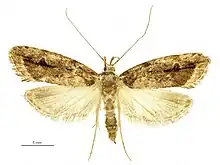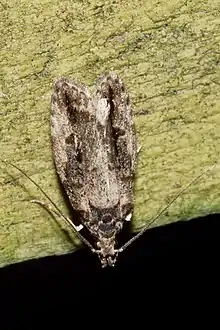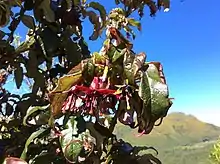| Izatha caustopa | |
|---|---|
 | |
| Female | |
 | |
| Male | |
| Scientific classification | |
| Domain: | Eukaryota |
| Kingdom: | Animalia |
| Phylum: | Arthropoda |
| Class: | Insecta |
| Order: | Lepidoptera |
| Family: | Oecophoridae |
| Genus: | Izatha |
| Species: | I. caustopa |
| Binomial name | |
| Izatha caustopa (Meyrick, 1892) | |
| Synonyms[1] | |
| |
Izatha caustopa is a lichen tuft moth in the family Oecophoridae. It is endemic to New Zealand, where it is known very locally, and very infrequently, from the southern half of the North Island: two specimens collected in 2016 were the first seen for 30 years. It is classified as "Data Deficient" by the Department of Conservation.
Taxonomy
This species was described by Edward Meyrick in 1892 using a female specimen collected by George Hudson in Wellington and named Semiocosma caustopa.[1][2] Hudson discussed and illustrated the species in his 1928 book The Butterflies and Moths of New Zealand.[3] The genus Semiocosma was subsequently synonymised with Izatha by Meyrick.[4] The holotype specimen is held at the Natural History Museum, London.[1]
Description
Meyrick originally described the species as follows:
♀︎ . 28mm. Head light fuscous, mixed with fuscous-whitish. Palpi ochreous-whitish, second joint suftusedly mixed with dark fuscous, terminal joint with dark-fuscous sub-basal ring and median band. Antennae rather dark fuscous. Thorax dark fuscous mixed with fuscous-whitish. (Abdomen broken.) Legs dark fuscouS; ringed with whitish ; posterior tibiae whitish. Forewings elongate, costa moderately arched, apex rounded, hindmargin almost straight, oblique ; fuscous-whitish, suffusedly mixed with fuscous and dark fuscous, veins remaining pale posteriorly ; a dark-fuscous basal patch, its outer edge angulated on discal tuft ; a large dark fuscous trapezoidal blotch occupying whole of disc, posterior edge well defined, near and parallel to hindmargin, other edges suffused ; a cloudy blackish dot in disc at 1⁄3 ; a cloudy black longitudinal streak from middle of disc to near apex, upper edge forming a rounded projection before 2⁄3 of disc, posterior extremity irregular, surrounded by fuscous suffusion : cilia fuscous, mixed with fuscous- whitish. Hindwings fuscous-whitish, posteriorly sprinkled with fuscous ; cilia fuscous-whitish, suffusedly mixed with light fuscous [2]
I. caustopa has a rather large wingspan for the genus: 24–26 mm for males and 29–31.5 mm for females.[4]
Distribution

This species is endemic to New Zealand.[5][6] Although only known very locally this species has been found in the Taupo, Hawkes Bay, and Wellington areas.[4] Hudson noted this species was found in a few patches of tree fuchsia at Gollans Valley and Wilton's Bush, Wellington; he collected his last specimen in 1942.[7] A single specimen was collected in Ohakune in 1921, and two more at Puketitiri (near Napier), in 1964 and 1985.[4] I. caustopa had not been seen for 30 years when two specimens was discovered in 2016 at Bushy Park near Whanganui.[8][9]
Biology and host species


Hudson reared the moths from dead branches of kōtukutuku (Fuchsia excorticata) collected in Karori, Wellington. He noted the larvae "feed during the winter months... driving burrows through the soft wood in all directions"—like most lichen tuft moths, they are probably feeding on fungi.[3][4] They are full grown by about October.[3] Adults have been recorded mostly in January and February, with single records for December and April.[4]
Conservation status and rarity
This species has been classified as having the "Data Deficient" conservation status under the New Zealand Threat Classification System.[10] Its rarity may be linked to the decline of its host tree, which is a favourite food of introduced possums.[4] It may actually be quite common in small pockets of forest in the North Island, and simply have been overlooked, since it is not attracted to bright light the way most moths are;[9] the specimens at Bushy Park were caught in a Malaise trap.[11]
References
- 1 2 3 Dugdale, J. S. (1988). "Lepidoptera - annotated catalogue, and keys to family-group taxa" (PDF). Fauna of New Zealand. 14: 1–269. ISBN 0477025188. Archived from the original (PDF) on 27 January 2019. Retrieved 1 June 2018.
- 1 2 Meyrick, E (1892). "On new species of Lepidoptera". Transactions and Proceedings of the New Zealand Institute. 24: 216–220 – via Biodiversity Heritage Library.
- 1 2 3 Hudson, G. V. (1928). The Butterflies and Moths of New Zealand. Wellington: Ferguson & Osborn Ltd. p. 280. OCLC 25449322. Archived from the original on 2020-09-28. Retrieved 2018-06-01.
- 1 2 3 4 5 6 7 Hoare, Robert R. J. (2 September 2010). "Izatha (Insecta: Lepidoptera: Gelechioidea: Oecophoridae)" (PDF). Fauna of New Zealand. Lincoln, Canterbury, New Zealand: Landcare Research New Zealand Ltd. 65: 1–201. ISSN 1179-7193. Archived from the original (PDF) on 26 January 2019. Retrieved 8 April 2018.
- ↑ Research, Landcare. "Izatha caustopa (Meyrick, 1892)". www.nzor.org.nz. Landcare Research New Zealand Ltd. Retrieved 2018-06-01.
- ↑ Gordon, Dennis P., ed. (2010). New Zealand inventory of biodiversity: Kingdom animalia: chaetognatha, ecdysozoa, ichnofossils. Vol. 2. p. 463. ISBN 978-1-877257-93-3. OCLC 973607714. OL 25288394M. Wikidata Q45922947.
- ↑ Hudson, George V. (1928). The Butterflies and Moths of New Zealand. Wellington: Ferguson & Osborn Ltd. p. 280. Archived from the original on 2018-01-16. Retrieved 2018-04-08.
- ↑ Priestley, Jo (15 February 2016). "Forest & Bird - Timeline Photos | Facebook". www.facebook.com. Retrieved 2016-02-15.
- 1 2 Maslin, John (15 February 2016). "Bioblitz uncovers vital information about insects". Wanganui Chronicle. Retrieved 15 February 2016.
- ↑ Hoare, R.J.B.; Dugdale, J.S.; Edwards, E.D.; Gibbs, G.W.; Patrick, B.H.; Hitchmough, R.A.; Rolfe, J.R. (2017). "Conservation status of New Zealand butterflies and moths (Lepidoptera), 2015" (PDF). New Zealand Threat Classification Series. 20: 5.
- ↑ Van Beynan, Jack (29 February 2016). "'Elusive' native moth re-discovered after 30 years". Stuff. Fairfax Media. Retrieved 29 February 2016.
External links
- Izatha caustopa discussed on Radio NZ Critter of the Week, 22 July 2016
- Image of holotype specimen of I. caustopa